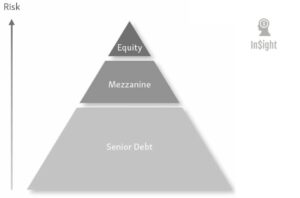Mezzanine debt refers to a type of financing that lies between traditional senior debt (such as bank loans) and equity in the capital structure of a company. It represents a form of subordinated debt that combines features of both debt and equity instruments. Mezzanine debt holders have a higher risk tolerance compared to senior debt holders but typically receive a higher potential return.

In the world of finance, mezzanine debt has gained popularity as an alternative investment option. It offers attractive returns to investors seeking higher yields than traditional fixed-income instruments. However, behind the allure of potential profits lie dangers and risks that demand careful consideration. In this blog post, we will shed light on the hidden hazards associated with buying mezzanine debt, allowing you to make informed decisions.
Subordinate Position:
Mezzanine debt typically holds a subordinate position in the capital structure of a company. This means that in the event of default or bankruptcy, mezzanine debt holders will be paid off after senior debt holders, leaving them exposed to greater risk. If the underlying company faces financial distress, the recovery prospects for mezzanine debt holders may be significantly diminished, leading to potential losses.
Complexity and Lack of Transparency:
Mezzanine debt investments can be complex and challenging to assess. Unlike publicly traded securities, mezzanine debt often lacks the transparency and oversight that comes with regulated markets. Investors may face difficulties in accurately evaluating the underlying assets, cash flows, and risks associated with these investments. Without proper due diligence, it becomes challenging to gauge the true value and sustainability of the investment.
Interest Rate and Payment Structure:
Mezzanine debt often carries a higher interest rate than traditional debt instruments, compensating investors for the additional risk they assume. However, the interest payments on mezzanine debt are often structured as “payment in kind” (PIK) or deferred payments. PIK interest accrues and is paid at a later date or upon maturity, leading to potential cash flow challenges for investors who rely on a regular income.
Market Dependency and Liquidity Risk:
Mezzanine debt is typically illiquid and lacks an active secondary market. Unlike publicly traded stocks or bonds, it can be difficult to find buyers or exit a mezzanine debt investment before maturity. This illiquidity exposes investors to significant liquidity risk, tying up their capital for extended periods. It can become problematic if the investor needs to access funds or respond to changing market conditions quickly.
Business Performance and Default Risk:
Investing in mezzanine debt inherently ties the investor’s fortunes to the performance and success of the underlying company. If the company’s financial health deteriorates or experiences operational challenges, the risk of default on the debt increases. Factors such as market conditions, industry disruptions, or poor management decisions can significantly impact the repayment ability of the company, thus jeopardizing the investment.
Lack of Collateral and Security:
Unlike senior debt holders, mezzanine debt investors often have limited or no access to collateral or security. In case of default, senior debt holders have a higher claim to the company’s assets, leaving mezzanine debt investors with diminished recovery prospects. This lack of collateral increases the risk exposure for mezzanine debt holders, as their recovery relies solely on the success and ability of the company to generate sufficient cash flows.
While mezzanine debt investments offer the potential for attractive returns, it is essential to understand the associated risks and hazards. Subordinate position, complexity, lack of transparency, interest payment structures, liquidity risk, business performance, and lack of collateral all contribute to the dangers involved in buying mezzanine debt. As an investor, thorough due diligence, risk assessment, and a well-diversified portfolio are crucial when considering this alternative investment option. It is advisable to consult with experienced financial professionals who can provide guidance tailored to your specific circumstances.



